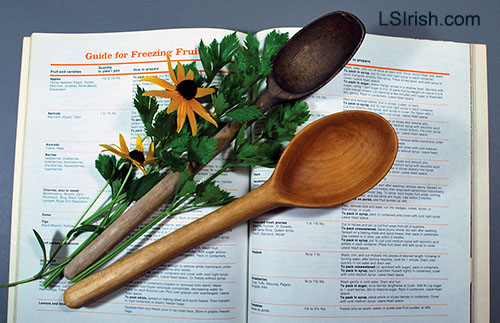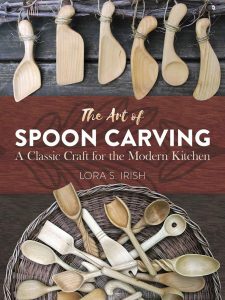One of the first things I did when I began working on this book, The Art of Spoon Carving, was to go to my kitchen spoon jar to look for common spoon bowl and handle shapes. Like many cooks I have a large assortment of oddly shaped spoons, each made for a different purpose and use in the kitchen. Among all the fancy modern spoons stood an old, blackened, broken-edge spoon that has survived nearly one and a half centuries of hard, loving use.
I don’t know if this spoon was factory-made or hand carved because the handle and bowl have become so smoothed from use that all of the cutting and tooling marks have long ago worn off.
The tip of the spoon is charred where it was used to adjust the kindling in the wood stove or used to push a hot griddle off the burner. The left side of the spoon bowl tip has been worn away, so I know that over the years the women that used this spoon were right-handed.
It long ago lost its bright, newly-cut wood look. The bowl is permanently stained to a black-brown tone because of decades of use in creating those wonderful paraffin-topped jars of blackberry jam and and Grandpa’s mulberry wine. The handle is now a deep beige tone from all the years of butter-coated hands.
This spoon was my Great Grandmother Elsie Burchnial Shay’s, wife of George L. Shay, born 1870 in Preston Co., West Virginia – five years after the end of the American Civil War. Like many of us, she could have been using this spoon as young as three, standing on a chair to reach the bowl on the kitchen table, learning to cook from her mother.
It was passed on to my Grandmother and then my mother, and now belongs to me.
My great Grandmother used it through WWI, and the Great Depression. My grandmother used it to make her daughters dinner when her husband was helping to build the Panama Canal and again during WWII. It was still stirring my mother’s starter batter for bread when man first walked on the moon and to make cookies to send to my brother during the Vietnam War.
It sits today in my kitchen spoon jar, ready for the next batch of ham and black bean soup.
As I held that spoon I thought of all the items that have come and gone through my life – expensive power tools that have been retired, furniture that was replaced, fine jewelry and store bought treasures that are no longer in fashion.
While my first computer that cost $3000 in 1997 is long gone, a simple wooden spoon, that around 1870 probably cost less than a penny, has not only survived but been cherished by four generations of women, and is still sitting in my spoon jar.
The Art of Spoon Carving uses this beloved old spoon so that you can learn how to carve your own wooden spoons that will become your family heritage treasures.
Available at Amazon.com
~ Lora Irish

